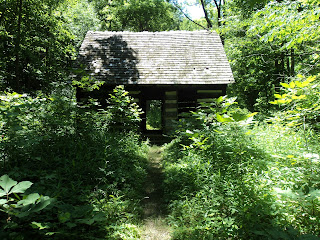Hike Location: Fort Hill Earthworks and Nature Preserve
Geographic Location: southeast of Hillsboro , OH (39.12153, -83.39665)
Length: 4.6 miles
Difficulty: 10/10 (Difficult)
Dates Hiked: November 2000, June 2013
Overview: A rugged course along Baker Fork followed by a steep climb to the fort.
Park Information: https://www.ohiohistory.org/visit/browse-historical-sites/fort-hill-earthworks-nature-preserve/
Directions to the trailhead: From Hillsboro , drive US 50 east 9.4 miles to SR 753 and turn right on SR 753. Take SR 753 south 7.1 miles to SR 41 and turn right on SR 41. Drive SR 41 south 0.6 miles to Fort Hill Road, a narrow, paved road that goes off on the right. Turn right and drive 1.6 miles to the state memorial entrance on the left. Park on the right side of the second and last parking lot.
The hike: Located in rural, rugged southeastern Highland County Hopewell culture. John Locke, a pioneer geologist of the early 1800's, became the first white man to document the fort's features in his 1838 work "Second Annual report on the Geological Survey of the State of Ohio ."
In 1932, the state of Ohio took advantage of an opportunity to purchase 237 acres containing the fort. 1000 additional acres have since been purchased to yield the current memorial. In 1968, a museum was built along the entrance road to interpret the fort's archaeological significance. The museum is open March through October.
The memorial is accessed by three concentric, interconnecting trails. The red-blazed Fort Trail is the shortest and easiest at 2.3 miles in length. This trail climbs 400 feet and loops around the top of Fort Hill, where the fort is located. It makes a good alternate for those unable to undertake more challenging hikes.
The route described here uses part of the Fort Trail and part of the yellow-blazed Gorge Trail, a 4.0-mile trail that loops around the base of Fort Hill. The outer-most loop is the 5.3 mile blue-blazed Deer Trail. Suited for the more conditioned and adventuresome, the Deer Trail is an extremely difficult trail over three hills with several steep sections. I note that all three trails involve steep climbs and caution regarding your ability and trail conditions should be exercised. An outline and drawing of the trails can be found at the information kiosk at the trailhead.
 |
| Information kiosk at trailhead |
 |
| Baker Fork |
 |
| Restored Log Cabin |
 |
| Small natural bridge |
 |
| Towering dolomite outcrop |
The trail takes a sharp right to join an old road, then a sharp left where the Buckeye Trail continues straight. Watch for the yellow blazes. Climbing gently, you soon come to another trail intersection where the Deer Trail exits to the right. Stay left on the Gorge Trail and begin a long moderate climb up Fort Hill. Over the next 0.3 miles the trail gains 200 feet in elevation to arrive at a junction with the Fort Trail. To view the fort, turn left on the red-blazed Fort Trail. The trail maintains a constant elevation as it traces the west side of Fort Hill. Notice the peaks and valleys in the fort wall, visible uphill and to the right, which look like turrets in a castle.
 |
| Final ascent to fort |
 |
| Fort earthworks |
 |
| View from View Point |
No comments:
Post a Comment